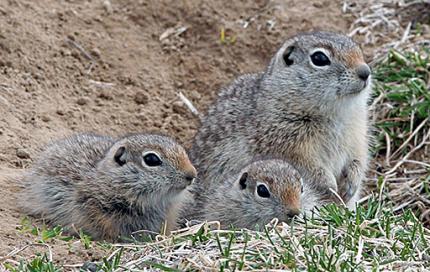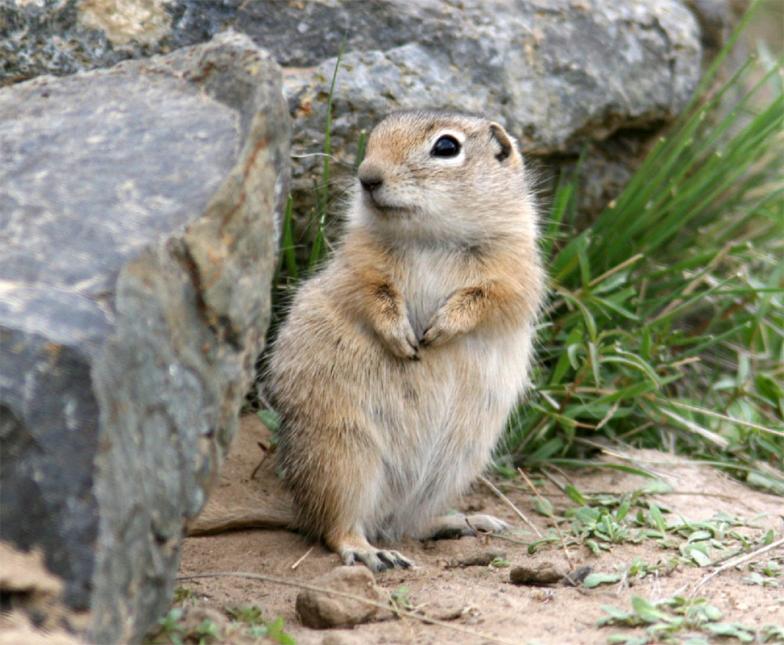Moderate-
High
The population of Washington ground squirrel is low. The Washington ground squirrel is associated with shrubsteppe and steppe in eastern Washington and is threatened by a number of factors, especially habitat loss, degradation, and fragmentation.
Description and Range
Physical description
Washington ground squirrels have short legs, small rounded ears, and a short tail (1 to 2 inches). They have a white eye ring, grayish white spots on their back, and a grayish-white underside. Males are slightly larger than females, with total body lengths of males and females ranging from 7 to 9 inches. They can be distinguished from other similar ground squirrels in Washington, due to their range, spotted fur on their back, and small ears.
Ecology and life history
Washington ground squirrels are a burrowing species found primarily in small to fairly large colonies, but sometimes occurring solitarily. Shrubsteppe and native grassland habitats are preferred, especially those occurring on deep silty loam soils, which provide ample digging space for burrows. Plants frequently found in these habitats include sagebrush, native bunchgrasses, and various forbs. Where adequate food is present, highly disturbed sites may also be occupied, including degraded weedy locations, highway right-of-ways, lawns, and edges along crop fields.

Diet is broad and comprised of mainly grasses, forbs, and seeds, with at least 100 plant species eaten.
Washington ground squirrels are active for only 4 to 5 months, spending the rest of the year hibernating. Adults emerge from hibernation during mid-Jan. to Feb. Mating occurs soon after emergence. Litters average 5 to 8 pups and first appear above ground in March to April.
During the two months before hibernation, adults and juveniles consume large amounts of food in an effort to gain adequate fat reserves to last through hibernation. Adults typically enter hibernation in late May and early June, but juveniles usually wait until mid to late June.
Life span is relatively short, probably averaging 2 to 3 years. Badgers, raptors, and snakes are the most important predators.
Geographic range
Washington ground squirrels occur only in the Columbia Basin region of eastern Washington and north-central Oregon. In Washington, the species is found east and south of the Columbia and Spokane Rivers. Historical records exist for 10 counties in the state, but several of these are no longer occupied. Population size is unknown, but the species has greatly declined or become extirpated in many areas.
For a map of range-wide distribution and conservation status of this species, check out NatureServe Explorer.
Climate vulnerability
Sensitivity to climate change
Moderate-
High
Sensitivity of Washington ground squirrels is likely driven by their association with shrub-steppe and grassland habitats (although they are able to inhabit a number of habitat subtypes which may decrease sensitivity). Warmer temperatures and changes in precipitation, including drought, could alter the quality and availability of important forage plants, affecting juvenile survival as well as the ability to accumulate adequate fat reserves before hibernation. Similar species (e.g., Piute ground squirrel, U. mollis) are known to decline during periods of drought. Warmer, drier conditions that lead to more frequent and hotter fires and/or encourage the growth of invasive weeds (e.g., cheatgrass) may degrade or alter natural habitat for Washington ground squirrels.
Exposure to climate change
Moderate
- Increased temperatures
- Changes in precipitation
- Drought
- Altered fire regimes
- Increased invasive species
Conservation
Conservation Threats and Actions Needed
- Fish and wildlife habitat loss or degradation
- Threat: Habitat loss and fragmentation due to agriculture and other development. Habitat fragmentation may isolate remaining populations.
- Action Needed: Use landowner agreements and conservation easements to protect significant colonies. Conduct translocations to establish new populations in suitable habitat.
- Invasive and other problematic species
- Threat: Invasion of shrubsteppe by cheatgrass and other non-native plants has degraded habitats.
- Action Needed: Restore and manage degraded habitat at colonies and sites chosen for translocations.
- Overharvesting of biological resources
- Threat: Some level of shooting and poisoning continues despite legal protection.
- Action Needed: Enforce existing protective regulations. Conduct education and outreach to landowners and recreationists.
- Resource information collection needs
- Threat: Current distribution and causes of recent declines are not well understood.
- Action Needed: Conduct surveys to monitor populations and trends. Conduct research to determine the causes of ongoing declines.
Our Conservation Efforts
Translocations
WDFW, with help from other agencies and volunteers, has conducted a series of Washington ground squirrel translocations since 2006, with squirrels moved to sites on public lands in Grant, Adams, Douglas, and Lincoln counties, including Columbia National Wildlife Refuge (NWR) and Columbia Basin Wildlife Area in an attempt to reestablish new populations in unoccupied areas of suitable habitat. Artificial tunnel systems were dug at both locations using a “burrow building” machine. A Columbia NWR translocation failed, probably because of high rates of predation by raptors perching on high nearby canyon walls. However, the Steamboat Rock translocation was quite successful.
Monitoring and surveys
Monitoring of Washington ground squirrel populations in Washington has continued at reduced levels since the 2004 comprehensive survey of known sites in Grant, Douglas, and Adams counties. Some sites are visited annually or less often to determine occupancy, but many others have not been checked since 2004. Surveys conducted since 2010 have located 237 new ground squirrel sites, many of which were found near a proposed Odessa irrigation canal system.
Research
A five-year study involving development of a long-term monitoring protocol for Washington ground squirrels was completed in 2012. Occupancy and detection modeling was used from 2008-2011 to determine the most efficient survey design for maximizing squirrel detections. A 2012 survey for ground squirrels was conducted at 204 random sample plots located in Douglas, Grant, Lincoln, and Franklin counties, with animals detected at 116 of the plots. This long-term monitoring effort is scheduled to occur every 3-5 years and was implemented in 2017 and 2022.
Habitat enhancement
WDFW conducted a habitat enhancement trial at the Seep Lakes Unit of the Columbia Basin Wildlife Area. The trial is intended to develop methods for restoring cheatgrass-dominated sites, where non-native annual forbs such as Russian thistle and tumble mustard are present.
Landscape management
The Washington Wildlife Habitat Connectivity Working Group addressed the conservation and restoration of habitat connectivity for numerous focal species, including Washington ground squirrels. Connectivity analyses were completed for the state in 2010 and for the Columbia Basin in 2012.
The Arid Lands Initiative is a group of governmental (WDFW, Washington Department of Natural Resources, Bureau of Land Management) and non-governmental organizations (The Nature Conservancy) formed in 2009 to engage landowners with the goal of conserving shrubsteppe across multiple jurisdictions in Washington. During 2012, members of the Initiative worked on prioritizing habitat types and species groups (e.g., grouse, burrowing animals) as targets for conservation efforts. Washington ground squirrels are one of the focal species for which conservation strategies will be developed and implemented.
Partners and cooperators
- U.S. Fish and Wildlife Service
- Sage Hills Golf Course
- Bureau of Land Management
- Cornell University
- The Nature Conservancy
- Washington Department of Natural Resources
Resources
References
Finger, R., G. J. Wiles, J. Tabor, and E. Cummins. 2007. Washington ground squirrel surveys in Adams, Douglas, and Grant Counties, Washington, 2004. Washington Department of Fish and Wildlife, Olympia, Washington.
USFWS. 2011. Species assessment and listing priority assignment form: Urocitellus washingtoni, Washington ground squirrel. U.S. Fish and Wildlife Service, Portland, Oregon.
WDFW publications
- Washington Ground Squirrel Surveys in Adams, Douglas, and Grant Counties, Washington 2004 (2007)
- Occupancy Modeling and Detection of Washington Ground Squirrels (Spermophilus washingtoni): Progress Report (2009)
